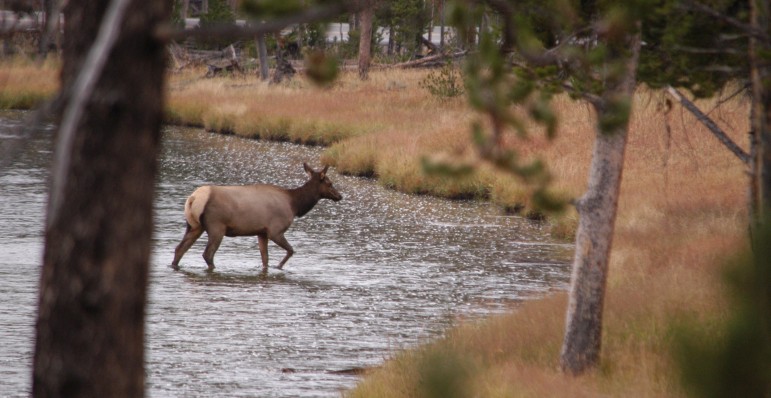
A proposal to study elk migration in the greater Yellowstone area and share information about the animals’ movements has won $100,000 in funding from a new contest aimed at supporting biodiversity studies in the region.
Yale University wildlife ecologist Arthur Middleton and South Dakota wildlife photographer Joe Riis were awarded the first Camp Monaco Prize, according to a statement released by the Buffalo Bill Center of the West in Cody, Wyo.
The prize, funded by the Center, the University of Wyoming and Prince Albert II of Monaco Foundation, will help pay for a study of the movements, productivity and conservation of migratory elk in the area around Yellowstone National Park.
In addition to publishing their findings, the project team will launch a public webcam to share live elk migration images at key bottleneck areas, produce a documentary film and create a photography archive in support of science, education and outreach. Researchers said the project will also look at the climatic influences on elk migration and explore the potential for long-term monitoring of ongoing elk migration via remote wilderness cameras.
Middleton recently published the findings of earlier research on pregnancy rates in the Clarks Fork elk herd, near Cody. That study was done with help from the Wyoming Cooperative Fish and Wildlife Research Unit, the Wyoming Game and Fish and U.S. Fish and Wildlife Service.
Though gray wolves prey on elk in the Clarks Fork herd, Middleton and his fellow researchers wanted to learn more about why elk cows in that herd were producing significantly fewer calves than other herds.
Though more research is needed, the data from that study showed that drought probably has a greater effect on poor birth rates than any stress that might be caused by wolves.
Riis has extensively documented in still photos and video the migration of pronghorn antelope in Wyoming, including through the area around Grand Teton National Park.
Middleton and Riis said in their project proposal that they hope to discover new ways of monitoring and safeguarding migratory wildlife in the Yellowstone region and in other important conservation areas across the globe.
The Camp Monaco Prize is named for a hunting camp established just east of Yellowstone Park in 1913 by Prince Albert I of Monaco and William F. “Buffalo Bill” Cody. That trip resulted in extensive press coverage and discussions of the American wilderness. The Prince’s great, great grandson, Albert II, arrives in Cody on Sept. 18 to mark the centennial of his ancestor’s adventure and to present the first Camp Monaco Prize.
More than 20 proposals were submitted for the 2013 Camp Monaco Prize from organizations, institutions and agencies from around the world.

The study indicating drought is the reason for diminishing elk herds begs the question: shouldn’t global climate change have been taken into consideration prior to wolf reintroduction? To add such a successful predator to the ecology in the face of serious drought conditions was like throwing gas on the flames. Apparently, drought would have taken care of the elk problem. We didn’t need the wolves
JIM- who do you know in the whole wide world , or Wyoming, that was even aware of Global Climate Change in 1994 when the wolf plans were finalized, let alone talking actively and expertly on Climate Change as a factor in anything ? Even the Yellowstone Fires of ’88 were attributed to just an unusual ” drought year” and 75 years of fire suppression etc etc etc , not fueled by climate change.
By the way , this article only presents a half truth when it alludes that wolves play only a secondary or opportunistic role in elk herd declines. While Middleton’s Absaroka Elk Ecology Study was given marching orders by its funders—the big elite hunting clubs and a shooting sports foundation —- to pay ” extra attention” to wolves hoping they could prove that wolves were inf act hammering elk herds, that did not happen. The science went elsewhere, towards climate and seasonal vegetation changes. What Middleton’s team suspected , but did not study per se, but has since been borne out by other research and observation, is that Grizzly bears and even Cougars are hammering Absaroka-Yellowstone migatory elk calves much more than wolves these days.
Your suggestion that reintroducing wolves on top of climate change was the primary accelerant to declining elk herds is hardly defensible. The matrix is large and complex. Just think for a moment about the effects of the Yellowstone Lake cutthroat trout crash (from man caused meddling ) , the Pine Beetle scourge, loss of Whitebark Pine , and the aftereffects of the Fires of ’88 in the larger picture.
Funny thing about how Nature works: the big elk herd units adjacent to the Sunlight Basin Yellowstone migratory elk corridor tha Middle studied are all growing in population, not declining, well above Wyo Game and Fish objectives. They all have complementary wolves, too. Perhaps the outfitters and sport hunters should consider not killing all the prime bulls tor estore some balance accelerated by poor hunting management for 50 years, instead of scapegoating the wolf
I was just trying to stir up controversy